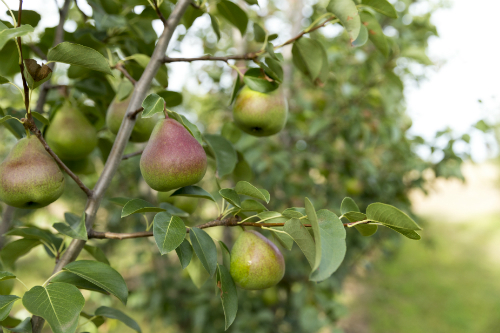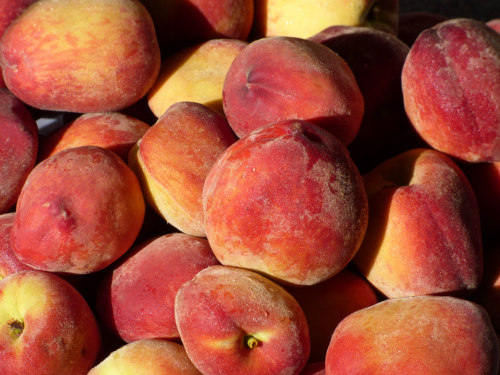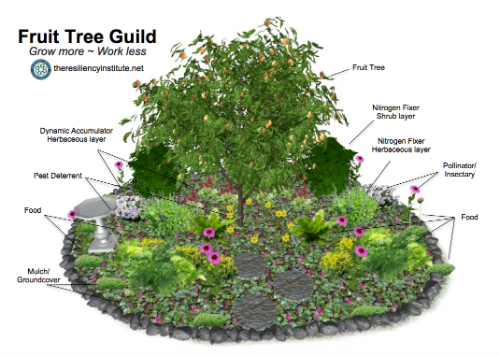By Melissa Ott Fant
In this summer update to our Fruit Tree Care series, we’re covering some important best practices for summertime in the orchard: summer pruning, weeding around fruit trees, and effective strategies for designing and planting understory plant communities, or guilds.
By this point in the summer, hopefully you’ve already thinned your fruit trees and have been regularly watering them if you live in a climate like California that experiences little or no rainfall in the summer. You can still thin your fruit if you didn’t earlier; the remaining fruit may still grow larger than if you don’t thin at all. However, the optimal time to thin your fruit is April to late May, depending upon the species and variety.
The University of California has a concise guide to thinning fruit trees here, and Stark Bro’s has some guidelines on their website here.
This video by Peaceful Valley Farm Supply explores some of the benefits and strategies of summer pruning and fruit thinning. Jump to 1:48 for the section on thinning.
What is Summer Pruning?
Back in February, we shared some resources related to winter fruit tree pruning in this blog post. (Some of the links we shared then might have summer pruning resources, too!) Even if you pruned your fruit trees in winter, there is more that you can do in the summer to maintain the shape, size, and health of your trees.
Summer pruning can slow down and redirect vegetative vigor, and encourage the tree to direct its resources toward fruit growth. With successful summer pruning, you can create openings for sunlight to shine into parts of the tree that would otherwise be shaded, and encourage the production of fruit buds.
As Orin Marin, Garden Manager at the UCSC Chadwick Garden says in this video, “Good fruit growing is about sunlight infiltration to all portions of the tree. Sunlight equals fruit.”
Summer pruning not only leads to better light infiltration, but it can also lead to sweeter fruit for that season’s harvest. Yum!
So how and when do we prune our trees in the summer?
Summer Pruning: Apples & Pears
In Santa Cruz, we summer prune apple and pear trees from from late July to late August. We do not summer prune the tips of primary scaffold branches of apples and pears; instead, we focus on the lateral (horizontal) branches, which is where fruit grows.
By summer pruning lateral branches, we can hasten the development of fruit buds for the next season. Summer pruning in July or August will allow vegetative buds to turn into fruit buds during the fall/winter so that next spring they flower and set fruit. Amazing!
More information about how to do this is outlined in this article by Orin Martin: “The How’s and Why’s of Summer Fruit Tree Pruning.” Scroll to the last page for a diagram showing where on the lateral branch you want to cut in order to encourage fruit bud development.

Photo by Apple and Pear Australia Ltd (Creative Commons License)
Summer Pruning: Peaches and Apricots
On peach and apricot trees, you can prune them 2-3 weeks before harvest time in order to get some color on the fruit. For vigorous stone fruit trees, summer pruning can also completely replace winter pruning.
Unlike apples and pears where we do not make summer heading cuts on the tips of primary scaffold branches, with vigorous stone fruits we do make summer heading cuts on the primary branches. The regrow response is like a heading cut made in winter but with less growth.
Learn more about the approaches to summer pruning in this article, “Thoughts on Pruning & Training Deciduous Fruit Trees.” As with most things in the garden and orchard, hands-on learning and developing muscle memory is the most effective way to learn summer pruning.
We offer an introductory lesson through our Permaculture Design Certificate Course weekend each spring-summer focused on “Home Scale Permaculture: Creating Natural Homes & Edible Landscapes.” In the winter, this weekend covers winter pruning.
You can also hire Santa Cruz Permaculture to summer prune your fruit trees! Visit our Services page for more information.

Yum! This is our goal with all of the hours of summer pruning, thinning, and tree care we provide throughout the year–large, ripe, colorful, and sweet fruit! Photo by Forest Starr and Kim Starr (Creative Commons License)
Weeding & Understory Plantings
Permaculture food forests and permaculture garden designs are well-known for their use of plant guilds, usually involving at least one variety of fruiting tree. How can we design guilds that provide a variety of ecological and culinary functions without interfering with the healthy growth of the fruit tree? Whether we plant understory species or not, we still have to weed the area around our trees each summer season, so we will also consider best practices for weeding around our trees.
Weeding Strategy
To weed around your trees, use hand tools like a scuffle/hula hoe and a digging fork. Be careful not to dig or hoe too deeply, or you can upset the roots of the tree. Remove weeds from below the entire canopy of the tree.
If you don’t plan on adding an understory layer of plants, you can cover the ground around the tree with a layer of wood chips or whatever locally sourced mulch you have, taking care to leave a six-inch wide ring of bare soil around the tree’s trunk to prevent rotting.
Chop and Drop
Another common strategy in permaculture food forests is to plant “mulch plants” that can be “chopped and dropped.” A classic example is comfrey. With its long tap root and lush green leaves, comfrey produces an abundance of leaves all summer long that can be harvested, chopped up, and left on the soil surface to act as a mulch.
Additionally, trimmings from herbaceous and woody flowering plants that you might cut back midsummer in order to force blooming again, such as buddleias or salvias, can be chopped and dropped as a mulch instead of put into the compost or green waste bin.
Lastly, plants that might be considered weeds in your orchard can often be chopped up and left on the soil surface as a mulch – just make sure they have not gone to seed yet.
Designing a Plant Guild
If you wish to plant living mulch that will attract beneficial insects and provide other ecological services to your orchard, spend some time designing and selecting the right species beforehand.
When putting together your guild of plants, consider the following:
— how they can support one another through the use of space
— their flowering and fruiting cycles throughout the seasons
— the possible benefits they provide, such as dynamic accumulation, attracting beneficial insects, providing habitat, etc.
Toby Hemenway, the late and great permaculture designer, teacher, and author, described plant guilds as “A group of organisms, usually plants […] that come together for a common purpose […] to support one another, just like the coopers guild and the goldsmiths guild […] that came together for their common purposes.”
The video below shows about thirteen and a half minutes of a presentation Toby gave on plant guilds. We teach this same lesson in our Permaculture Design Certificate course; the full slides of Toby’s presentation are available here.
Winter Squash
In addition to perennial guilds, you can also plant some annuals under your trees. Now would be a great time to plant winter squash below young trees. The squash will serve as a mulch to help prevent weeds from growing. The squash leaves can also alert you when it’s time to irrigate, if you don’t have your trees on automated watering. Trees don’t show signs of thirst as evidently as the squash will.
Comfrey
Another shout out to our friend Comfrey. It’s an excellent companion to fruit trees for many reasons:
— it’s a dynamic accumulator (helping to accumulate and cycle nutrients in soils)
— it has various medicinal uses
— its leaves make excellent green manure and mulch, and more!
Learn more about this awesome plant in this article from the Permaculture Research Institute. Comfrey also won’t spread too badly in your orchard as long as it is not rototilled and you take care only to use the leaves–not the root–for compost and mulch.
Community of Plants
When it comes to designing your understory guild, put together a list of many plants you would like to grow first. Learn about each one and consider how they will support one another throughout the season and years. Look for plants that bloom at different times so that you have pollinator-friendly habitat year-round.
Remember to consider how the plants you select will mature over time, both underground and above ground. Be sure to give each plant the room it needs to grow and thrive now and in future years, including your fruit tree.
As you design your plant guild around your tree, maintain access pathways so that you can summer and winter prune, thin, and care for your tree throughout the year without squishing your plant guild members in the understory with your orchard ladder.

Photo by the Resiliency Institute
For more on this subject, here are some additional resources:
— “Piecing Together a Guild of Your Own” by the Permaculture Research Institute
— “Mulch vs plants under trees?” forum discussion on Permies.com
— “Fruit tree guilds and edible companion plants (Apple, Pear, Peach, Plum)” forum discussion on Permies.com
Have you designed and planted a fruit tree guild in your orchard? We’d love to see photos and hear about your design process. We may even feature your fruit tree guild story on social media! Send us an email at santacruzpermaculture[at]gmail[dot]com or contact us through Facebook here.
Get some hands-on pruning time this winter by signing up for our next Permaculture Design Certificate Course. It starts October 6, 2018! The final early bird savings deadline is Wednesday, August 15, 2018. Learn more on our website.
This is part three in a series of posts about fruit tree planting and care throughout the seasons. Read other posts about fruit trees here.
